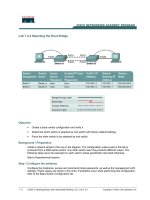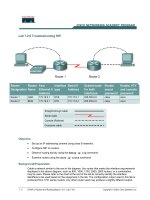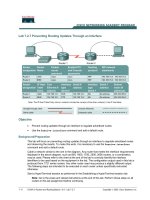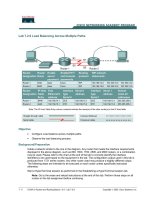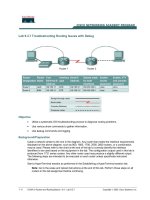Tài liệu Lab 7.3.8 Unequal Cost Load Balancing with IGRP docx
Bạn đang xem bản rút gọn của tài liệu. Xem và tải ngay bản đầy đủ của tài liệu tại đây (132.77 KB, 6 trang )
Lab 7.3.8 Unequal Cost Load Balancing with IGRP
Router
designation
Router
name
Enable
secret
password
Enable/VTY/ and
Console passwords
Routing
protocol
RIP
network
statements
Router 1 MAD class cisco IGRP
192.168.41.0
192.168.50.0
192.168.52.0
Router 2 MIL class cisco IGRP
192.168.50.0
192.168.52.0
192.168.33.0
Router
designation
IP
host
name
FastEthernet
0 address
Interface
type
Serial 0
Serial 0
address
Interface
type
Serial 1
Serial 1
address
Subnet mask
all addresses
Router 1 MIL 192.168.41.1 DCE 192.168.50.1 DCE 192.168.52.1 255.255.255.0
Router 2 MAD 192.168.33.1 DTE 192.168.50.2 DTE 192.168.52.2 255.255.255.0
Objective
• Observe unequal-cost load balancing.
• Tune IGRP networks by using advanced debug commands.
Background/Preparation
In this lab, a default route will be configured and RIP used to propagate this default information to
other routers. When this configuration is working properly, the network will be migrated from RIP to
IGRP and default routing will be configured to work with that protocol as well.
Cable a network similar to the one in the diagram. Any router that meets the interface requirements
displayed on the above diagram, such as 800, 1600, 1700, 2500, and 2600 routers, or a
combination, may be used. Please refer to the chart at the end of the lab to correctly identify the
1 - 6 CCNA 2: Routers and Routing Basics v 3.0 - Lab 7.3.8 Copyright 2003, Cisco Systems, Inc.
interface identifiers to be used based on the equipment in the lab. The configuration output used in
this lab is produced from 1721 series routers. Any other router used may produce a slightly different
output. The following steps are intended to be executed on each router unless specifically instructed
otherwise.
Start a HyperTerminal session as performed in the Establishing a HyperTerminal session lab.
Note: Go to the erase and reload instructions at the end of this lab. Perform those steps on all
routers in this lab assignment before continuing.
Step 1 Configure the hostname and passwords on the routers
a. On the routers, enter the global configuration mode and configure the hostname as shown in the
chart. Then configure the console, virtual terminal and enable passwords. If there are problems
doing this, refer to the Configuring router passwords lab. Next configure the interfaces according
to the chart. If there are problems doing this, refer to the Configuring Host Tables lab. Finally
configure IGRP routing on the routers using the Autonomous System (AS) of 34. If there are
problems doing this, refer to the Configuring IGRP lab. Make sure to copy the running-
config to the startup-config on each router.
Step 2 Configure bandwidth on the Madison router interfaces
a. In order to make unequal cost load balancing to work, it is necessary need to establish different
metrics for the IGRP routes. This is done with the bandwidth command. The serial 0 interface
will be set to a bandwidth of 56K and the serial 1 interface will be set to a value of 384K. The
route-cache must also be turned off for load balancing. Both serial interfaces must use process
switching. Process switching forces the router to look in the routing table for the destination
network of each routed packet. In contrast fast-switching, which is the default, stores the initial
table lookup in a high-speed cache and uses the info to route packets to the same destination.
Enter the following statements on the Madison router:
MAD(config)#interface serial 0/0
MAD(config-if)#bandwidth 56
MAD(config-if)#no ip route-cache
MAD(config-if)#interface serial 0/1
MAD(config-if)#bandwidth 384
MAD(config-if)#no ip route-cache
b. Because the IGRP metric includes bandwidth in its calculation, bandwidth must be manually
configured on the serial interfaces in order too ensure accuracy. For the purposes of this lab, the
alternative paths to network 192.168.41.0 from the Madison router are not of unequal cost until
the appropriate bandwidths are set.
c. Use the show interface command output to verify the correct bandwidth settings and the
show ip interface command to ensure that fast switching is disabled.
d. Can the bandwidth of Ethernet interfaces be set manually? _________________________________
Step 3 Configure the hosts with the proper IP address, subnet mask and default gateway
a. Test the configuration by pinging all interfaces from each host. If the pinging is not successful,
troubleshoot the configuration.
Step 4 Use the variance command to configure unequal-cost load balancing
a. The variance value determines whether IGRP will accept unequal-cost routes. An IGRP router
will only accept routes equal to the local best metric for the destination multiplied by the variance
value. So if the local best metric of an IGRP router for a network is 10476, and the variance is 3,
the router will accept unequal-cost routes with any metric up to 31428 or 10,476 x 3. This is as
2 - 6 CCNA 2: Routers and Routing Basics v 3.0 - Lab 7.3.8 Copyright 2003, Cisco Systems, Inc.
long as the advertising router is closer to the destination. An IGRP router accepts only up to four
paths to the same network.
Note: An alternate route is added to the route table only if the next-hop router in that path is
closer to the destination (has a lower metric value) than the current route.
b. By default, IGRP’s variance is set to 1, which means that only routes that are exactly 1 times the
local best metric are installed. Therefore, a variance of 1 disables unequal-cost load balancing.
c. Configure the Madison router to enable unequal-cost load balancing using the following
commands:
MAD(config)#router igrp 34
MAD(config-router)#variance 10
d. According to the help feature, what is the maximum variance value? _________________________
e. Check the Madison routing table. It should have two routes to network 192.168.33.0 with
unequal metrics.
f. What is the IGRP metric for the route to 192.168.33.0 through serial 0? ______________________
g. What is the IGRP metric for the route to 192.168.33.0 through serial 1? ______________________
Step 5 Check Basic Routing Configuration
a. Enter show ip protocol command on each router.
b. Enter the command show ip route on both routers. List how the route is connected
(directly, IGRP), the IP address and via through what network. There should be four routes in
each table.
GAD
Route connected IP address Through Network / Interface
BHM
Route connected IP address Through Network / Interface
c. Circle the evidence of load balancing in the above output.
Step 6 Verify per-packet load balancing
a. Because there are two routes to the destination network, half the packets will be sent along one
path, and half will travel over the other. The path selection alternates with each packet received.
b. Observe this process by using the debug ip packet command on the Madison router.
c. Send a 30 ping packets across the network from the host attached to Milwaukee router to the
host attached to the Madison router. As the pings are sent, the router outputs IP packet
information. Stop the debug after the pings by using the command undebug all.
d. Examine and record part of the debug output.
3 - 6 CCNA 2: Routers and Routing Basics v 3.0 - Lab 7.3.8 Copyright 2003, Cisco Systems, Inc.
e. What is the evidence of load balancing in the output? ______________________________________
Step 7 Verify per-destination load balancing
a. After verifying per-packet load balancing, configure the router to use per-destination load
balancing. Both serial interfaces must use fast switching so that the route-cache can be used
after the initial table lookup.
b. Use the command ip route-cache on both serial interfaces of the Madison router.
c. Use the show ip interface to verify that fast switching is enabled.
d. Is fast switching enabled? ______________________________________________________________
The routing table is consulted only once per destination. Therefore, packets that are part of a packet
train to a specific host will all follow the same path. Only when a second destination forces another
table lookup or when the cached entry expires will the alternate path be used.
e. Use the debug ip packet command and ping across the network. Note which serial
interface the packet was sent out on.
f. Use the debug ip packet command and ping across the network. Note which serial
interface the packet was sent out on.
g. Examine and record part of the debug output.
h. Which serial interface was the packet sent out on? ________________________________________
Upon completion of the previous steps, log off by typing exit and turn the router off.
4 - 6 CCNA 2: Routers and Routing Basics v 3.0 - Lab 7.3.8 Copyright 2003, Cisco Systems, Inc.
Erasing and reloading the router
Enter into the privileged exec mode by typing enable.
If prompted for a password, enter class. If “class” does not work, ask the instructor for assistance.
Router>enable
At the privileged exec mode enter the command erase startup-config.
Router#erase startup-config
The responding line prompt will be:
Erasing the nvram filesystem will remove all files! Continue?
[confirm]
Press Enter to confirm.
The response should be:
Erase of nvram: complete
Now at the privileged exec mode enter the command reload.
Router(config)#reload
The responding line prompt will be:
System configuration has been modified. Save? [yes/no]:
Type n and then Enter.
The responding line prompt will be:
Proceed with reload? [confirm]
Press Enter to confirm.
In the first line of the response will be:
Reload requested by console.
After the router has reloaded the line prompt will be:
Would you like to enter the initial configuration dialog? [yes/no]:
Type n and then Enter.
The responding line prompt will be:
Press RETURN to get started!
Press Enter.
The router is ready for the assigned lab to be performed.
5 - 6 CCNA 2: Routers and Routing Basics v 3.0 - Lab 7.3.8 Copyright 2003, Cisco Systems, Inc.
